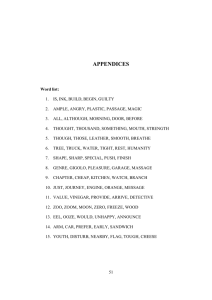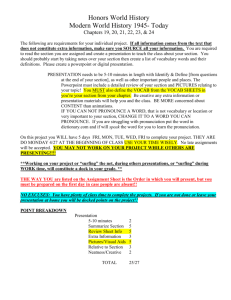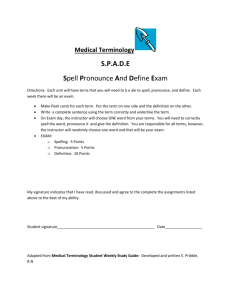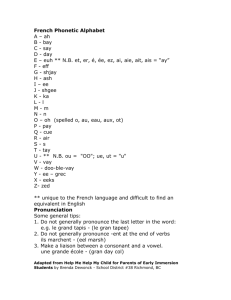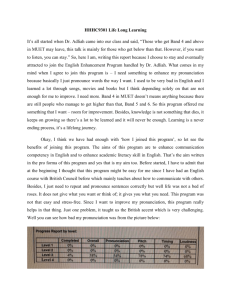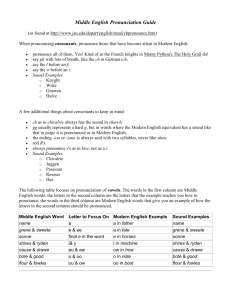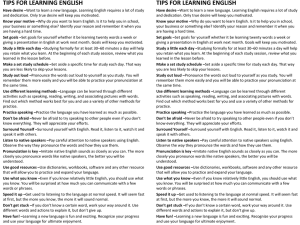Scranton School District Course Syllabus
advertisement
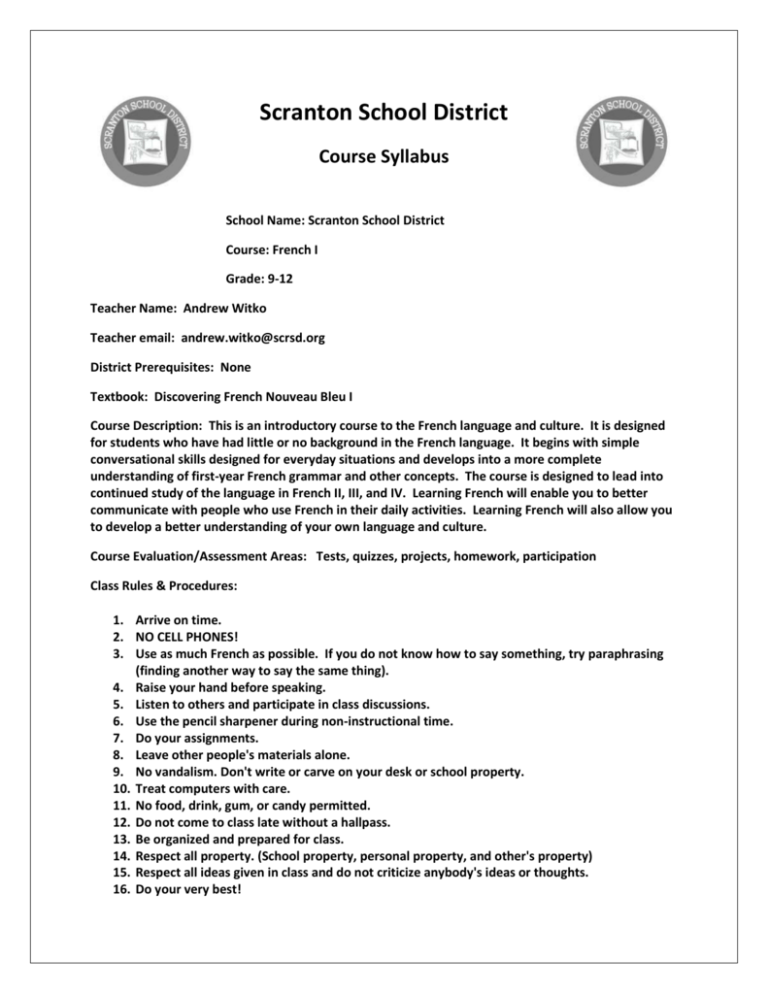
Scranton School District Course Syllabus School Name: Scranton School District Course: French I Grade: 9-12 Teacher Name: Andrew Witko Teacher email: andrew.witko@scrsd.org District Prerequisites: None Textbook: Discovering French Nouveau Bleu I Course Description: This is an introductory course to the French language and culture. It is designed for students who have had little or no background in the French language. It begins with simple conversational skills designed for everyday situations and develops into a more complete understanding of first-year French grammar and other concepts. The course is designed to lead into continued study of the language in French II, III, and IV. Learning French will enable you to better communicate with people who use French in their daily activities. Learning French will also allow you to develop a better understanding of your own language and culture. Course Evaluation/Assessment Areas: Tests, quizzes, projects, homework, participation Class Rules & Procedures: 1. Arrive on time. 2. NO CELL PHONES! 3. Use as much French as possible. If you do not know how to say something, try paraphrasing (finding another way to say the same thing). 4. Raise your hand before speaking. 5. Listen to others and participate in class discussions. 6. Use the pencil sharpener during non-instructional time. 7. Do your assignments. 8. Leave other people's materials alone. 9. No vandalism. Don't write or carve on your desk or school property. 10. Treat computers with care. 11. No food, drink, gum, or candy permitted. 12. Do not come to class late without a hallpass. 13. Be organized and prepared for class. 14. Respect all property. (School property, personal property, and other's property) 15. Respect all ideas given in class and do not criticize anybody's ideas or thoughts. 16. Do your very best! Units of Instruction 1. 2. 3. 4. 5. 6. 7. 8. 9. 10. 11. 12. 13. 14. 15. 16. 17. 18. 19. 20. 21. First Quarter: Cultural: La Rentrée (First Day of School) Salutations (Moi/Toi) (Formal and Casual) L’alphabet (Alphabet-Pronunciation Differences) Orthographic signs (aka..accent marks) Numbers (0-10) Telling where one is from. Nationalities Adjectives (Masculine/Feminine) Short answers and “Time Buying” expressions (oui, non, et, aussi, etc.) Cultural (Martinique and French national territory overseas) Numbers (10-20) Mute (Silent Letters..final consonants) Numbers (20-60) Feelings of frustration and appreciation (using “Ça va?”) Appropriate greetings (differences) between friends and adults) Commands (To get someone’s attention) Indefinite Articles (Un/Une) Cultural (French concept of Friendship) Numbers 60-79 Project: Typing in a Foreign Language Supplementary (Cultural, If time allows): Life of Joan of Arc Second Quarter: 1. Inquiring about other people (names, where they are from, what they do, etc.) 2. Direct Articles (Le, La, L’, Les) 3. Using the telephone (etiquette) 4. Numbers (80-100) 5. Pronunciation: Nasal Vowels 6. Cultural: Québec 7. Age (Giving and finding out) 8. Family Members (including pets) 9. Possessive adjectives (Mon/Ma, Ton/Ta) 10. Pronunciation: Nasal Vowels (continued) 11. Colors 12. Cultural: French and American concepts of family. 13. Food (expressing hunger..asking if someone is hungry, offering food to eat) 14. Indefinite Articles (Un, Une, Des) 15. Pronunciation: Intonation 16. Culture: Fast Food in France. 17. Thirst (expressing thirst, asking if someone is thirsty, identifying and ordering beverages) 18. “S’il te plaît, S’il vous plait” (Please) 19. Pronunciation: Intonation (continued) 20. Cultural: French cafés Third Quarter: 1. Describing daily activities. 2. How to say what people do and don’t do. 3. How to talk about what you want, would like, and do not want or like to do. 4. How to invite a friend, accept an invitation, and turn down an invitation. 5. How to use je veux and je ne veux pas. 6. Cultural: To learn about daily activities of French young people. 7. How to talk about where people are. 8. How to ask and answer using yes/no questions. 9. How to express negation. 10. How to use subject pronouns. 11. How to use the verb être and the negative ne…pas. 12. How to use yes/no questions with est-ce que. 13. How to pronounce /a/. 14. Cultural: To talk about where French young people spend their free time. 15. How to describe what one person or several people are doing or not doing. 16. How to talk about what people like and don’t like to do. 17. How to express approval or regret. 18. How to use a verb + infinitive construction. 19. How to use regular er verbs. 20. How to pronounce the vowels /i/ and /u/. 21. Cultural: To become familiar with French party customs. 22. How to ask for information and to ask about people. 23. How to ask and describe what people are doing. 24. How to express mild doubt or surprise. 25. How to use the verb Faire. 26. How to ask information questions using est-ce que and to form questions with inversion. 27. How to pronounce the vowel /y/. 28. Cultural: To become aware of French heritage in Senegal. Fourth Quarter: 1. 2. 3. 4. 5. 6. 7. 8. 9. 10. 11. 12. 13. 14. 15. 16. How to describe people’s physical appearance and age. How to identify objects. How to discuss what one owns and doesn’t own, and whether these things work or not. How to describe one’s room, what’s in it, and where things are located. How to use the expression il y a. Cultural: To learn about the multi-cultural reality of contemporary France. How to talk about what one has. How to identify and designate people and things. How to express negation. How to discuss repeated events. How to contradict a negative statement or question. How to use singular/plural and masculine/feminine nouns. How to use the verb avoir and expressions with avoir. How to use definite articles in general statements and to indicate repeated events. How to use the indefinite article and the negative article pas de. How to pronounce the articles le and les. 17. 18. 19. 20. 21. 22. 23. 24. 25. 26. 27. 28. 29. 30. 31. Cultural Goals: To learn about Haiti. How to describe people and objects. How to talk about character traits and nationality. To talk about where things are made. How to introduce a conclusion. How to understand adjective formation and position. How to pronounce final consonants on feminine forms but not on masculine forms. Cultural: How to understand importance of Friendship for the French. How to use adjectives of aspect and color to describe possessions. Hot to get someone’s attention. How to express opinions. How to use il est and c’est. How to position adjectives correctly. How to pronounce the letters “ch”. Culture: To learn about French people and their automobiles.
